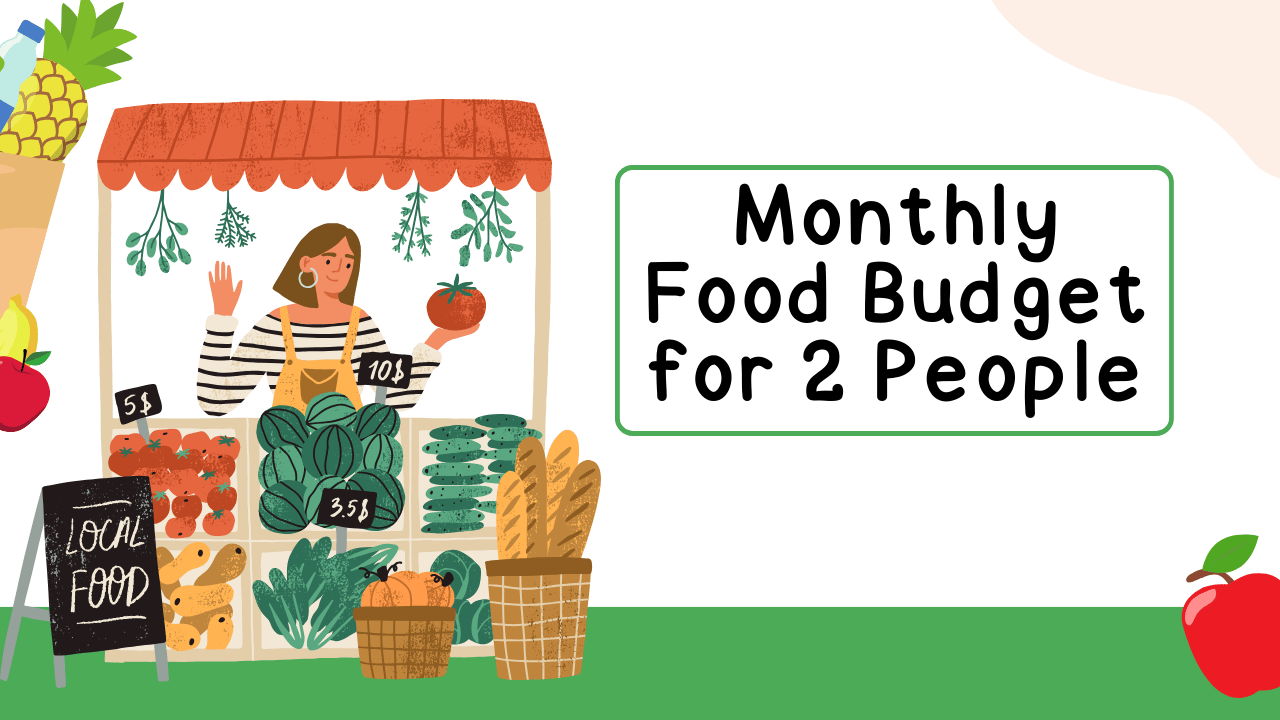Feeding a household of two can be both exciting and challenging. A well-planned monthly food budget for 2 ensures that you eat healthy, save money, and avoid food waste. Whether you’re a couple, roommates, or family members sharing meals, this guide will help you design a realistic food budget while maximizing value.

We’ll explore average costs, provide tips for saving money, and suggest meal plans tailored to your needs. Let’s dive in!
Why a Food Budget is Essential
Budgeting for food is more than just tracking expenses; it’s about managing your resources efficiently. Here are some reasons why a food budget is critical:
- Financial Control: Prevent overspending on groceries or dining out.
- Healthy Eating: Allocate funds to fresh and nutritious ingredients.
- Reduced Waste: Plan meals to minimize unused or spoiled food.
By setting a monthly food budget, you can achieve a balance between enjoying meals and maintaining financial stability.
Average Monthly Food Budget for 2
The average cost of feeding two people depends on location, dietary preferences, and lifestyle. However, here are some general benchmarks:
1. Frugal Budget
- Cost: $300–$400 per month
- Focus on simple, home-cooked meals with basic ingredients like rice, beans, vegetables, and affordable proteins.
2. Moderate Budget
- Cost: $500–$700 per month
- Includes a mix of home cooking, quality ingredients, and occasional dining out.
3. Liberal Budget
- Cost: $800–$1,200+ per month
- Allows for premium groceries, frequent dining out, and gourmet cooking.
Keep in mind that costs may vary due to inflation, regional price differences, and dietary restrictions.
How to Calculate Your Monthly Food Budget for 2
Here’s a step-by-step approach to determining a budget that works for you:
Step 1: Assess Your Income and Expenses
Allocate a percentage of your monthly income to food. Experts recommend spending 10–15% of your income on groceries and dining.
Step 2: Track Your Current Spending
Review past grocery bills and dining receipts to understand your habits.
Step 3: Adjust for Goals
Are you aiming to save money or eat healthier? Modify your budget accordingly.
Step 4: Factor in Special Diets
Consider additional costs for organic, gluten-free, or specialty items.
Essential Components of a Food Budget
1. Groceries
- Fruits, vegetables, grains, proteins, and dairy make up the bulk of grocery expenses.
- Tip: Shop seasonally for fresh and affordable produce.
2. Dining Out
- Limit eating out to special occasions or budgeted meals.
- Tip: Use apps for discounts at local restaurants.
3. Snacks and Beverages
- Include coffee, tea, snacks, and occasional treats in your budget.
4. Meal Prep Supplies
- Allocate funds for reusable containers, wraps, and meal prep tools.
Tips to Save Money on Your Monthly Food Budget for 2
1. Meal Planning is Key
- Plan meals for the week to reduce impulsive purchases.
- Use overlapping ingredients to cut costs.
2. Shop Smart
- Look for sales, discounts, and coupons.
- Buy in bulk for non-perishable items like grains and canned goods.
3. Avoid Food Waste
- Store perishables properly to extend freshness.
- Use leftovers creatively in soups, salads, or casseroles.
4. Cook at Home
- Home cooking is significantly cheaper than dining out.
- Experiment with simple recipes to keep things interesting.
5. Prioritize Nutrient-Dense Foods
- Choose foods that are filling and packed with nutrients, such as eggs, lentils, and frozen vegetables.
Sample Monthly Meal Plan for 2
Here’s an example of how you can organize meals on a moderate budget:
Week 1
- Breakfast: Oatmeal with fruit
- Lunch: Sandwiches with a side salad
- Dinner: Pasta with marinara and roasted vegetables
Week 2
- Breakfast: Scrambled eggs and toast
- Lunch: Chicken salad wraps
- Dinner: Stir-fried vegetables with rice
Week 3
- Breakfast: Yogurt and granola
- Lunch: Soups with crackers
- Dinner: Baked salmon with quinoa
Week 4
- Breakfast: Smoothies with protein powder
- Lunch: Leftovers from dinner
- Dinner: Tacos with beans and toppings
Common Pitfalls to Avoid
1. Overbuying Perishables
- Stick to your grocery list to avoid spoilage.
2. Impulse Purchases
- Shop on a full stomach to resist temptation.
3. Ignoring Unit Prices
- Compare costs per ounce or pound for the best value.
4. Forgetting to Budget for Treats
- Occasional splurges are okay but plan for them in advance.
Tools to Help Manage Your Food Budget
- Budgeting Apps: Tools like Mint or YNAB can track expenses.
- Meal Planning Apps: Apps like Mealime or Plan to Eat simplify grocery shopping.
- Spreadsheets: Create a custom Excel sheet to monitor your spending.
Conclusion
Planning a monthly food budget for 2 doesn’t have to be complicated. By assessing your income, tracking expenses, and making intentional choices, you can enjoy nutritious and delicious meals without breaking the bank. Whether you’re cooking gourmet meals or sticking to a frugal plan, a well-thought-out budget ensures that you’re both satisfied and financially secure.
Take control of your food spending today—start planning your monthly food budget and savor the benefits of smart financial management!



